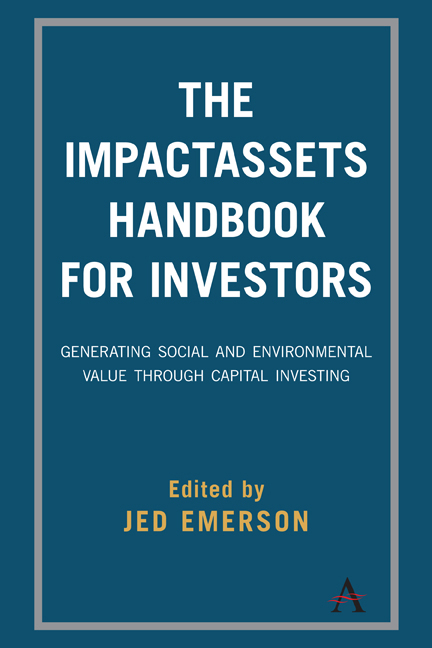 The ImpactAssets Handbook for Investors
The ImpactAssets Handbook for Investors Book contents
- Frontmatter
- Dedication
- Contents
- List of Contributors
- Preface
- Introduction
- 1 Construction of an Impact Portfolio: Total Portfolio Management for Multiple Returns
- 2 Total Portfolio Management: One Practitioner's Approach
- Case Study 1
- Case Study 2
- Case Study 3
- 8 The Measurement Challenge
- Case Study 4
- Appendix: Impact Investing Resources
- Notes on Contributors
- Index
2 - Total Portfolio Management: One Practitioner's Approach
Published online by Cambridge University Press: 15 October 2019
- Frontmatter
- Dedication
- Contents
- List of Contributors
- Preface
- Introduction
- 1 Construction of an Impact Portfolio: Total Portfolio Management for Multiple Returns
- 2 Total Portfolio Management: One Practitioner's Approach
- Case Study 1
- Case Study 2
- Case Study 3
- 8 The Measurement Challenge
- Case Study 4
- Appendix: Impact Investing Resources
- Notes on Contributors
- Index
Summary
Elsewhere in this book, the reader will discover any number of threads that, when woven together, reveal the tapestry that is Total Portfolio Management (TPM). Better Investing. Better philanthropy. The future of capital markets. Metrics and reporting. How to work with advisors. An inevitable evolution of the way we deploy capital. More responsible stewardship of the environment. Less exploitative markets. And all based on the braided notions that:
At some point, it will simply be unacceptable to invest while disregarding the environmental or social consequences of doing so, and
Most people, at least subconsciously, want a better world.
This chapter is but one of those threads. And while it has the benefit of a great deal of thought and capital behind it, it should be taken as neither gospel, nor as light-hearted advice, nor as yet another idealistic vision of how the world “should” be. Rather, think of it as a set of reflections on how one might deploy an impact-integrated portfolio along the lines of TPM; guardrails rather than a railroad. For, just as in conventional investing, there are any number of ways to invest well, in impact investing there are any number of ways to create durable, measurable value. In other words, I write not tell you how you should pursue impact. I am here to share how we pursue impact. And, hopefully, this process of sharing will illuminate your path and provide some amount of encouragement, inspiration or simply permission to get started.
More specifically, this chapter examines one practitioner's application of TPM through the narrower lens of so-called finance first impact investing. Although I have never liked the term finance first (we reject the implied impact/ finance trade-off), it does capture the essence of how we think about impact investing: solving first for our client's financial requirements, and then pursuing impact to the maximum extent possible within a given asset allocation and a defined thematic orientation. Said differently, we think of investing as deploying capital through various types of investment strategies and instruments to achieve the multiple returns our clients seek—financial performance with integrated consideration of social and environmental impacts.
- Type
- Chapter
- Information
- The ImpactAssets Handbook for InvestorsGenerating Social and Environmental Value through Capital Investing, pp. 47 - 74Publisher: Anthem PressPrint publication year: 2017


